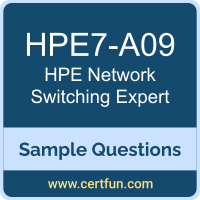 Getting knowledge of the Hewlett Packard Enterprise HPE7-A09 exam structure and question format is vital in preparing for the HPE Network Switching Expert certification exam. Our HPE Network Switching Expert sample questions offer you information regarding the question types and level of difficulty you will face in the real exam. The benefit of using these Hewlett Packard Enterprise HPE7-A09 sample questions is that you will get to check your preparation level or enhance your knowledge by learning the unknown questions. You will also get a clear idea of the exam environment and exam pattern you will face in the actual exam with the HPE Network Switching Expert Sample Practice Test. Therefore, solve the HPE ACX-Switch sample questions to stay one step forward in grabbing the HPE Aruba Networking Certified Expert - Switching credential.
Getting knowledge of the Hewlett Packard Enterprise HPE7-A09 exam structure and question format is vital in preparing for the HPE Network Switching Expert certification exam. Our HPE Network Switching Expert sample questions offer you information regarding the question types and level of difficulty you will face in the real exam. The benefit of using these Hewlett Packard Enterprise HPE7-A09 sample questions is that you will get to check your preparation level or enhance your knowledge by learning the unknown questions. You will also get a clear idea of the exam environment and exam pattern you will face in the actual exam with the HPE Network Switching Expert Sample Practice Test. Therefore, solve the HPE ACX-Switch sample questions to stay one step forward in grabbing the HPE Aruba Networking Certified Expert - Switching credential.
These Hewlett Packard Enterprise HPE7-A09 sample questions are simple and basic questions similar to the actual HPE Network Switching Expert questions. If you want to evaluate your preparation level, we suggest taking our HPE Network Switching Expert Premium Practice Test. You might face difficulties while solving the real-exam-like questions. But, you can work hard and build your confidence on the syllabus topics through unlimited practice attempts.
Hewlett Packard Enterprise HPE7-A09 Sample Questions:
01. Which factor most influences the decision between Layer 2 and Layer 3 access designs in enterprise networks?
a) The requirement for port-based QoS
b) The need for access layer resiliency
c) The use of HPE Aruba Central for monitoring
d) The number of VLANs in each wiring closet
02. Why should Equal-Cost Multi-Path (ECMP) be enabled in a Layer 3 core fabric?
a) It adds VLAN redundancy in Layer 2
b) It provides loop-free BGP routes
c) It allows load balancing across multiple next hops
d) It prevents route redistribution
03. A network administrator is asked to monitor link stability and CPU utilization on core switches and take action when thresholds are breached. Which three NAE tasks should be implemented?
(Select three answers)
a) Deploy threshold-based triggers on CPU
b) Monitor interface operational status
c) Export logs to public syslog collector
d) Configure alert and email notification
e) Disable switchport on threshold breach
04. Which two conditions may lead to asymmetric routing in an ECMP-enabled network?
(Select two answers)
a) Uniform path costs
b) Misaligned routing policies
c) Unequal bandwidth per path
d) Disabled jumbo frame support
05. What is the most effective way to ensure configuration compliance across multiple AOS-CX switches managed in Aruba Central?
a) Schedule a nightly SNMP poll
b) Enable NTP sync on all devices
c) Configure a syslog server for each device
d) Use group-based configuration templates
06. When should an engineer prefer using HPE Aruba Networking Central over CLI for device configuration?
a) When deploying a standalone switch
b) When automating template-based provisioning at scale
c) When troubleshooting a one-time Layer 3 routing loop
d) When accessing local console logs
07. Which two symptoms typically indicate a routing loop in an OSPF-enabled Layer 3 topology?
(Select two answers)
a) Frequent MAC address changes
b) High TTL values in traceroute
c) Multiple equal-cost next-hops per route
d) Continual route flapping in routing table
08. A government agency implements MACsec and role-based access control using downloadable roles. Some users complain about intermittent access and slow login authentication. Which three troubleshooting areas are most relevant?
(Select three answers)
a) Verify RADIUS timeout and retransmit settings
b) Check if MACsec negotiation fails due to key mismatch
c) Validate policy mapping for dynamic VLANs
d) Inspect NAT table for TCP session reuse
e) Confirm PoE budget allocations
09. What is the result of using NetEdit’s intent-based configuration model on AOS-CX switches?
a) Commands are sent immediately to the switch without validation
b) Users can write JSON automation scripts
c) Configuration is compared against desired state before deployment
d) CLI access is disabled
10. A switch port should be configured as an ________ port when it connects to a user endpoint and belongs to a single VLAN.
a) access
b) routed
c) trunk
d) loopback
Answers:
|
Question: 01 Answer: d |
Question: 02 Answer: c |
Question: 03 Answer: a, b, d |
Question: 04 Answer: b, c |
Question: 05 Answer: d |
|
Question: 06 Answer: b |
Question: 07 Answer: a, d |
Question: 08 Answer: a, b, c |
Question: 09 Answer: c |
Question: 10 Answer: a |
Note: For any error in HPE Network Switching Expert (HPE7-A09) certification exam sample questions, please update us by writing an email on feedback@certfun.com.
